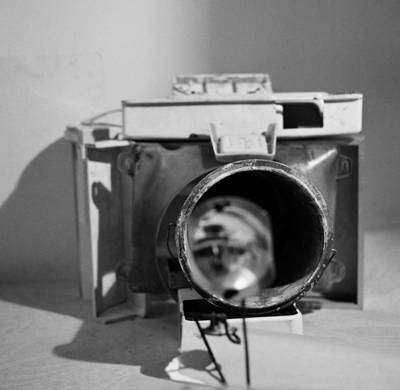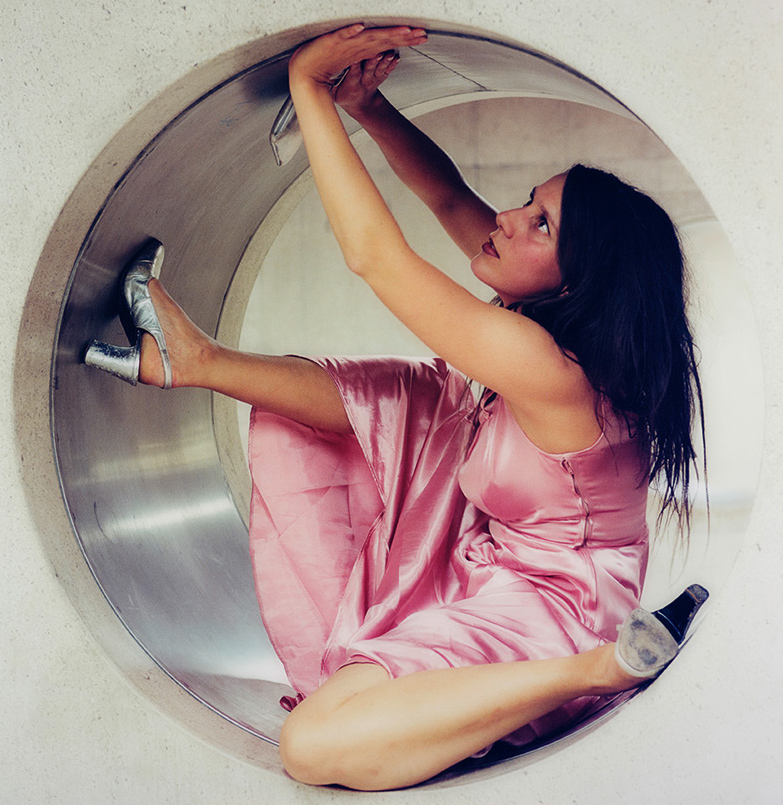Small Disc Ultramarine Blue Intenso, 2010
Christian Herdeg (b. 1942), Small Disc Ultramarine Blue Intenso, 2010,
MDF, argon and gouache paint, 118 x 118 x 8 cm

video stills from: Walking in the museum, 1997

Untitled, 2022
Elise Corpataux (b. 1994), Untitled, 2022, from the series: ALL YOU HAVE IS NOW,
oil and acrylic on canvas, 33 x 26.5 cm

Jalousie III, 2017
Bernard Voïta (b. 1960), Jalousie III, 2017,
lacquered steel, closed: 80 x 62 x 7 cm, open: 197 x 62 x 112 cm

hideout.40, 2012
Monica Ursina Jaeger (b. 1974), hideout.40, 2012,
Chinese ink and pigment transfer on paper, 115 x 160 cm
Maternité de Morges, 1980
Monique Jacot (b. 1934), Maternité de Morges, 1980,
photograph on paper, 21 x 31 cm

Gather together, 2021
Simone Holliger (b. 1986), Gather together, 2021,
paper, glue, paint and boat varnish, 93.5 x 60 x 15.5 cm

Misr, 2008

Stripping, 1998
Teresa Hubbard (b. 1965) / Alexander Birchler (b. 1962), Stripping, 1998,
C-print on Dibond, 145 x 180 cm, © Teresa Hubbard / Alexander Birchler

My sister never sleeps, 2009
Katrin Freisager (b. 1960), My sister never sleeps, 2009,
C-print on Diasec, 80 x 98 cm

TAFAA – UNNECESSARY DOUBT, 2023
Chloé Delarue (b. 1986), TAFAA – UNNECESSARY DOUBT, 2023,
latex, resin, aluminium and neon, 110 x 74 x 8 cm

Interieur, 1997
Silvia Gertsch (b. 1963), Interieur, 1997,
acrylic and lacquer on glass, 63 x 84 cm

Kraftstrasse 35, Eine Installation (IV), 1992

Island Parasite II, 2013
Franziska Furter (b. 1972),
Island Parasite II, 2013, metal and wire, 44 x 66 x 52 cm

Kinetic Replacement III, 2016
Sara Masüger (b. 1978), Kinetic Replacement III, 2016,
Acrystal, wood and tiles, 22 x 80 x 82 cm

Jane’s Room, 2022
Deborah-Joyce Holman (b. 1991), Jane’s Room, 2022,
oil and pencil on linen canvas, 100 x 178 x 4.3 cm

Copier 01, 2021
Bastien Aubry (b. 1974), Copier 01, 2021,
papier collé, acrylic paint, starch glue and wood, 100 x 75 x 65 cm

Barking up a Tree, 2016
Vittorio Brodmann (b. 1987), Barking up a Tree, 2016,
oil on fabric, double sided, 208 x 142 cm

Barking up a Tree, 2016
Vittorio Brodmann (b. 1987), Barking up a Tree, 2016,
oil on fabric, double sided, 208 x 142 cm

Gutter-Hydrant, 1974
Alfredo Aceto (b. 1991), Gutter-Hydrant, 2018,
polystyrene, fibreglass, acrylic resin and paint, 80 x 30 x 45 cm

Kalk 15/V, 2015
Daniel Robert Hunziker (b. 1965), Kalk 15/V, 2015,
powder-coated metal, 115 x 95 x 12 cm

Melencolia IV, 2014
Bernard Voïta (b. 1960), Melencolia IV, 2014,
inkjet print on paper, 180 x 130 cm

Filmstills - The End, Rig, 2010–2011
Teresa Hubbard (b. 1965) / Alexander Birchler (b. 1962), Filmstills - The End, Rig, 2010–2011,
C-print on paper, 110.5 x 137 cm, © Teresa Hubbard / Alexander Birchler

Untitled, 2000

video still from: Fire, 2014
Taiyo Onorato (b. 1979) / Nico Krebs (b. 1979), video still from: Fire, 2014,
16 mm film transferred onto SD DVD, 6' 59''

Untitled, 2018
Loredana Sperini (b. 1970), Untitled, 2018,
concrete, wax and pigment, 30 x 15.5 x 5.5 cm

–, F#9844, 1999
Bob Gramsma (b. 1963),–, F#9844, 1999,
Lambda print behind acrylic glass, 122 x 194 cm, © 2023, Pro Litteris, Zurich

Marzahn 1, from the series: Building Berlin/Constructions, 2009
Taiyo Onorato (b. 1979) / Nico Krebs (b. 1979), Marzahn 1, from the series: Building Berlin/Constructions, 2009,
silver gelatin print on Baryta paper, 131.3 x 104.7 cm

Whispering system XVI, 2022
Julia Steiner (b. 1982), Whispering system XVI, 2022,
galvanised grass (copper), 74 x 28 x 2.5 cm

Rulers, 2019
Annaïk Lou Pitteloud (b. 1980), Rulers, 2019,
rulers, 25 x 25 x 2.5 cm

Untitled, 2007
Klodin Erb (b. 1963), Untitled, 2007,
oil on canvas, 140 x 200 cm

The Default Brain, Les Grands Ensembles, 2022
Marc Bauer (b. 1975), The Default Brain, Les Grands Ensembles, 2022,
charcoal and oil on canvas, mounted on Dibond, 160 x 120 cm

Porta VII, 2019

House Fountain (Over Flow), 2015
Florian Graf (b. 1980), House Fountain (Over Flow), 2015,
glazed ceramic and water pump, 75 x 37 x 37 cm

Komposition-48, 2012
Shirana Shahbazi (b. 1974), Komposition-48, 2012,
C-print on aluminium, 90 x 70 cm

Corpus Oeconomicus, 2021
Mathis Altmann (b. 1987), Corpus Oeconomicus, 2021,
LED matrix screen, video loop, 2’ 15’’, stainless-steel mirror, acrylic glass, photo print and adhesive tape, 152 x 77 x 13 cm

video still from: Maison, 2012
Augustin Rebetez (b. 1986), video still from: Maison, 2012,
HD video, 10' 28''

Ensemble of Five (Between Two Waves), 2020–2021
Sonia Kacem (b. 1985), Ensemble of Five (Between Two Waves), 2020–2021,
fabric, wood and metal, 5 elements, 80 x 58 x 35 cm each

Schlaf, 1997
Thomas Huber (b. 1955), Schlaf, 1997,
watercolour on paper, 110.5 x 180.5 cm, © 2023, Pro Litteris, Zurich

Studio, 2000

La Nuit des Tours (Shadow’s Eve), 2015

Jimny, 2016
Charlotte Herzig (b. 1983), Jimny, 2016,
acrylic on canvas, 154 x 120 cm

Whispering system XIV, 2022
Julia Steiner (b. 1982), Whispering system XIV, 2022,
galvanised grass (copper), 62 x 54 x 3.5 cm

Abnorm, 2006

La Salle, Zürich, 2002
Stephanie Couson (b. 1970), La Salle, Zürich, 2002,
photograph on aluminium, 100 x 100 cm

Untitled, 1999
Erika Maack (b. 1969), Untitled, 1999,
photography, behind Plexiglas, mounted on aluminium, 118 x 125.5 cm

Untitled, 2001
Christoph Schreiber (b. 1970), Untitled, 2001,
Lambda print on aluminium, 59 x 49 cm, © 2023, Pro Litteris, Zurich

Untitled, 2012
Loredana Sperini (b. 1970), Untitled, 2012
bronze, 125.5 x 32 x 2 cm

Not yet titled, 2016
Sonia Kacem (b. 1985), Not yet titled, 2016,
awning fabric and wood, 190 x 170 x 41 cm

Rieterpark, 1999
Caro Niederer (b. 1963), Rieterpark, 1999,
oil on canvas, 150 x 120 cm

Haus und Acker, 2016
El Frauenfelder (b. 1979), El Frauenfelder (b. 1979), Haus und Acker, 2016,
collage, oil paint on canvas on corrugated cardboard, 29 x 36 cm

Brote aus anderem Licht, 2005

Das Licht, das auf eine Bank fällt, 1992
Marc-Antoine Fehr (b. 1953), Das Licht, das auf eine Bank fällt, 1992,
oil on paper, 49 x 115 cm

No Dice #1 (White), 2022
Cassidy Toner (b. 1992), No Dice #1 (White), 2022,
resin and acrylic, 31.5 x 56.6 x 2 cm

verliebt in die Planeten - über den Hang gedrängt, 2007
Dominique Lämmli (b. 1964), verliebt in die Planeten - über den Hang gedrängt, 2007,
Ilfochrome on aluminium on Dibond, 120 x 102 cm

Camera I, 2003

Ein merkwürdiger Wettlauf und eine weitschweifige Geschichte, 2000

Zürich - Werdstrasse 75, 25.7.2006
Andrea Good (b. 1968), Zürich - Werdstrasse 75, 25.7.2006,
photograph on coloured paper, 35 min. exposure time, 182.9 x 180.2 cm



